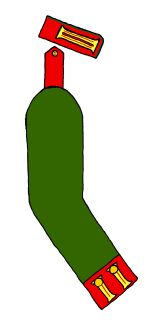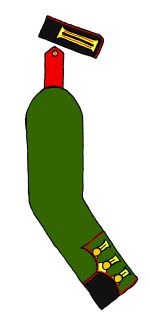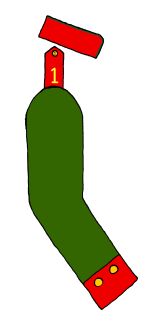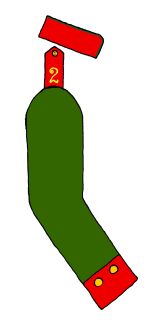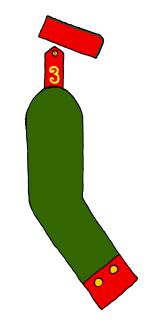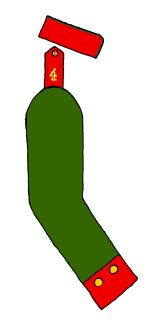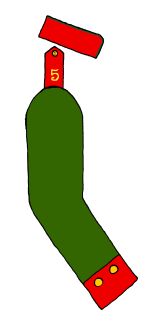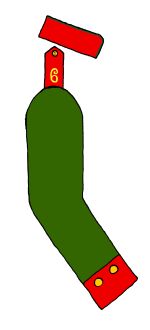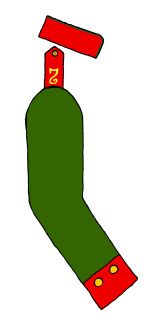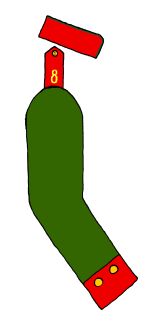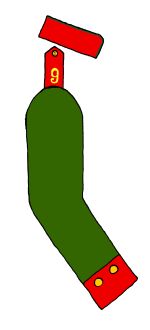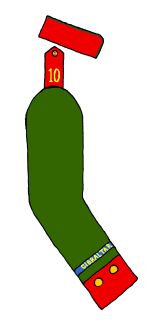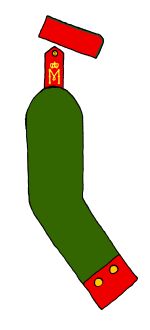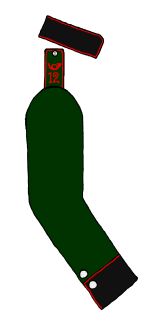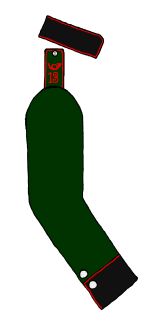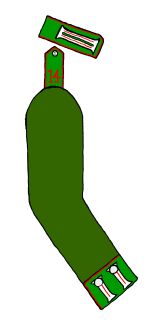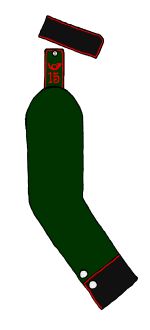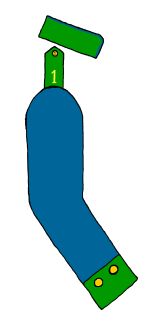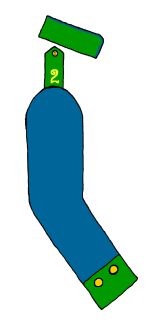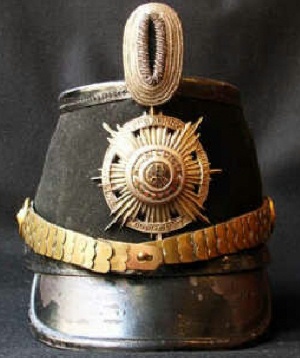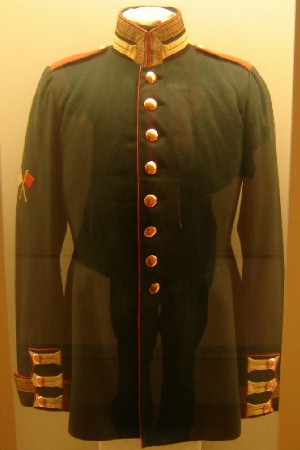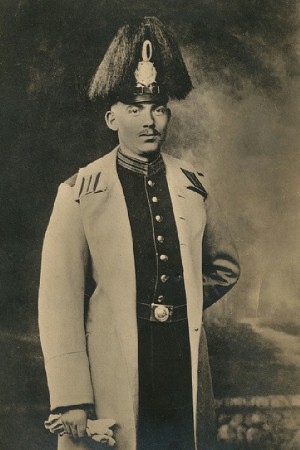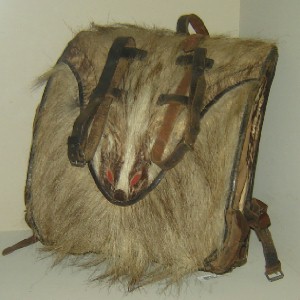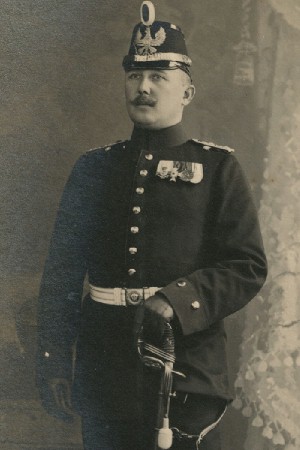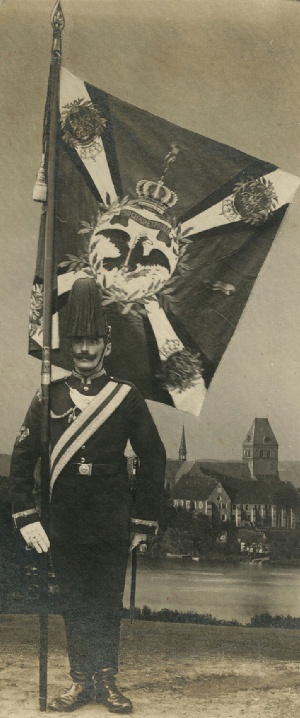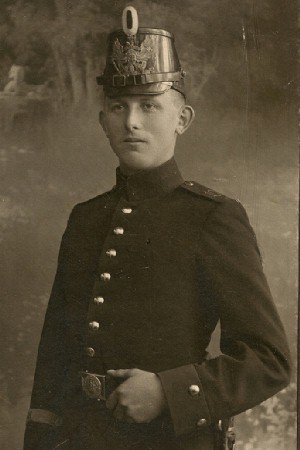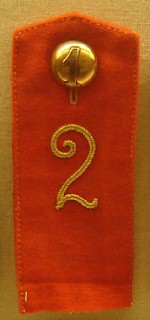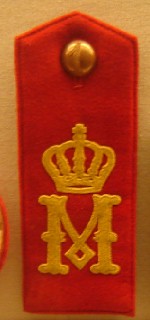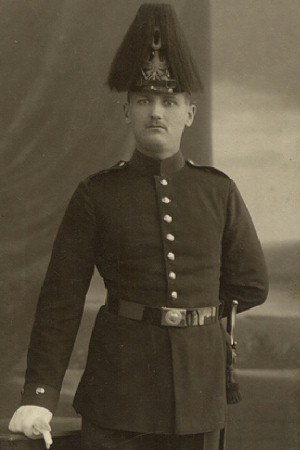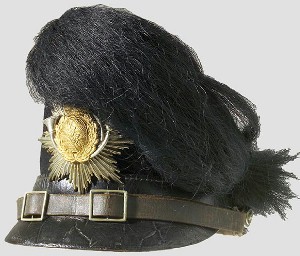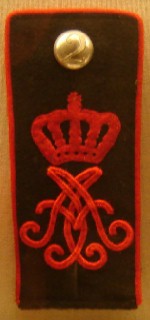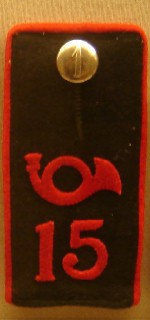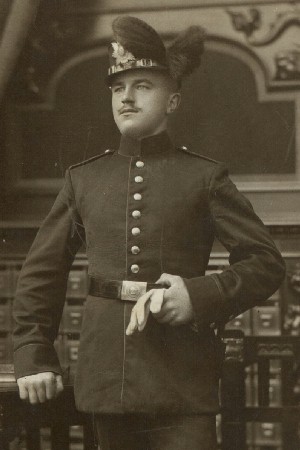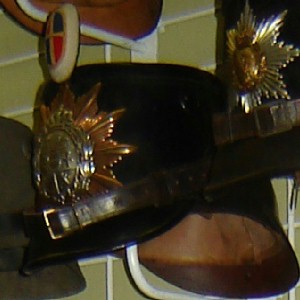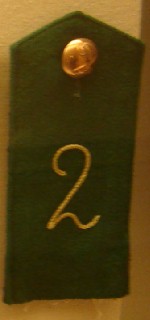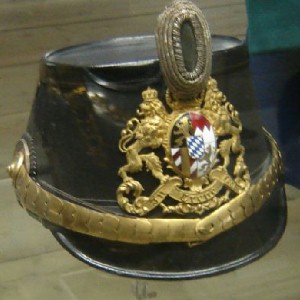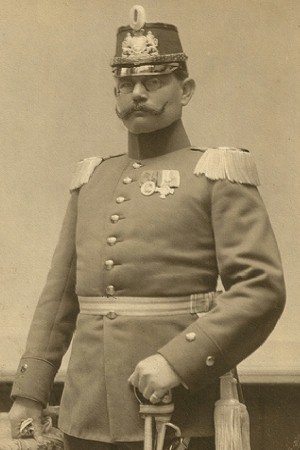|
The uniforms of
the light infantry battalions were basically the
same as for the Prussian infantry but in dark
green (very dark green for Saxony, pale blue for
Bavaria) and with Swedish style cuffs (French
style cuffs for the Guard Rifles, Saxon style
cuffs for Saxony). Buttons were in yellow metal
(white metal for Saxony and Mecklenburg). Prussian Jäger
Battalions had red collars shoulder straps, collars
(piped along the upper edge in dark green), cuffs,
hatbands and piping. The Schützen and Bavaria, Saxony
and Mecklenburg wore different colours and designs
described below. The headdress was a black
leather shako (kepi-shako for Saxony) made from
polished black leather with a polished metal front plate and
Imperial and state cockades on the right and
left sides respectively as on the infantry
Pickelhaube and an additional oval state cockade
at the top (replaced by a black horsehair plume
for Saxony). On parade a black horsehair plume was worn
above the cockade (red horsehair plume for musicians).
Prussian Guard
Jäger Battalion
The
Garde-Jäger-Batallion was formed in 1744 as part
of the
Korps Feldjäger zu Fuss
of Frederick the Great's army during the War of Austrian
Succession and first saw action against the Austrians in Silesia in 1745. In 1808 as part of the
re-organisation of the Prussian army after the Treaty of Tilsit,
the Korps Feldjäger zu
Fuss was divided into the Guard, 1st and 2nd Battalions.
They took part in most of
Prussia's campaigns from then (the Seven Years War, the War of
Bavarian Succession, the Dutch Patriot Rebellion, the French Revolutionary and Napoleonic
Wars, the Austro-Prussian War and the Franco-Prussian) notably seeing action at the
Battles of Kaiserslautern
in 1793, Jena in 1806, Leipzig in 1813,
Königgrätz
in 1866, Gravelotte-St.Privat, Sedan and the Siege of Paris in
1870.
In 1914
they were garrisoned at Potsdam and formed part of the
Guard Army Corps. During the First World War they saw action on
both the Western and Eastern Fronts (including the Battles of
the Somme and Verdun).
| Uniform
Distinctions |
| Shako Plate: |
White metal Prussian Guard
Star |
| State
Cockade: |
Prussian (black/white/black) |
| Oval
Shako Cockade: |
Prussian (white/black) |
| Capband and
piping: |
Red |
| Tunic
Buttons: |
Yellow metal |
| Shoulder
Straps: |
Plain red |
| Collar: |
Red piped along the upper
edge in green with Yellow double Litzen |
| Cuffs: |
Swedish style in red
with yellow Litzen |
Prussian Guard Schützen
Battalion
The
Garde-Schützen-Batallion was formed in
1814, originally with recruits from the Swiss Principality of Neuchatel of which King Friedrich Wilhelm III was then
ruler. In
1848 Neuchatel declared itself a republic within the Swiss
Confederation, autonomous from
Prussia and later recruits for the Guard Schützen came from
other parts of the Kingdom of Prussia.
The Guard Schützen
Battalion saw action
against rioters in Berlin in 1848 and against Denmark later the
same year. They also served in the Austro-Prussian War
(including the Battle of Königsgrätz) and the France-Prussian
War (including the Battles of Gravelotte-St.Privat, Sedan and
the Siege of Paris).
In 1914
they were garrisoned at Berlin-Lichterfeld and formed part of the
Guard Army Corps. During the First World War they saw action on
both the Western and Eastern Fronts (including the Battles of
the Somme and Verdun).
| Uniform
Distinctions |
| Shako Plate: |
White metal Prussian Guard
Star |
| State
Cockade: |
Prussian (black/white/black) |
| Oval
Shako
Cockade: |
Prussian (white/black) |
| Capband and
Piping: |
Black with red piping |
| Tunic
Buttons: |
Yellow metal |
| Shoulder
Straps: |
Plain red |
| Collar: |
Black collar piped in red
with yellow double Litzen |
|
Cuffs: |
French
style cuffs in black, piped in red. French style cuffs
were unique to the Guard Schützen Battalion and the
Guard Machine Gun Company. |
1st Prussian
Jäger Battalion (East Prussian)
The
Jäger-Batl.Graf Yorck von Wartenburg (Ostpreußisches)
Nr.1 was formed in
1744 as part of the
Korps Feldjäger zu Fuss
of Frederick the Great's army during the War of Austrian
Succession and first saw action against the Austrians in Silesia in 1745
and again in the Seven Years War. They took part in the 1812 Invasion of Russia as part of
Napoleon's Grande Armée, then fought against Napoleon in
the campaigns of 1813-15. They later fought in the
Austro-Prussian War at the Battle of Königgrätz and in the
Franco-Prussian War at the Battle of Gravelotte-St.Privat.
In 1914
they were garrisoned at
Ortelsburg (modern
Szczytno, Poland) and formed part of the
XX Army Corps. During the First World War they first served on the
Eastern Front (notably at the Battle of Tannenberg), then from
1917 in Italy and from Spring 1918 on the Western
Front.
| Uniform
Distinctions |
|
Shako Plate: |
Yellow metal Prussian "Old
Grenadier" eagle with FWR monogram in an oval shield on
the breast |
|
State Cockade: |
Prussian (black/white/black) |
|
Oval Shako Cockade: |
Prussian (white/black) |
|
Capband and Piping: |
Red |
|
Tunic Buttons: |
Yellow
metal |
|
Shoulder Straps: |
Red with
yellow number 1 |
|
Collar: |
Red |
|
Cuffs: |
Swedish
style in red |
2nd Prussian
Jäger Battalion (Pomeranian)
The
Jäger-Batallion Fürst Bismarck (Pommersches) Nr.2 was formed in 1744 as
part of the
Korps Feldjäger zu Fuss
of Frederick the Great's army during the War of Austrian
Succession and first saw action against the Austrians in Silesia in 1745.
They also fought in the Seven Years War, Napoleonic Wars, the
Austro-Prussian War (at the Battle of Königgrätz) and in the
Franco-Prussian war at the Battle of Gravelotte-St.Privat and
the Siege of Paris.
In 1914
they were garrisoned at
Kulm (modern
Chełmno, Poland) and formed part of the
XVII Army Corps. During the First World War they served on the
Eastern and later Western
Fronts.
| Uniform
Distinctions |
|
Shako Plate: |
Yellow metal Prussian "Old
Grenadier" eagle with FWR monogram in an oval shield on
the breast |
|
State Cockade: |
Prussian (black/white/black) |
|
Oval Shako Cockade: |
Prussian (white/black) |
|
Capband and Piping: |
Red |
|
Tunic Buttons: |
Yellow
metal |
|
Shoulder Straps: |
Red with
yellow number 2 |
|
Collar: |
Red |
|
Cuffs: |
Swedish
style in red |
3rd Prussian
Jäger Battalion (Brandenburg)
The
Brandenburgisches
Jäger-Batallion Nr. 3 was formed in
1815 as the Feld-Jäger Batallion of the Prussian II Army
Corps. They served in both the Schleswig Wars of 1849 and 1864
against Denmark, and at Königgrätz against Austria 1866. They
also fought at the Battles of
Mars-la-Tour
and
Gravelotte-St.Privat
in the Franco-Prussian War of 1870.
In 1914
they were garrisoned at Lübben and formed part of the
III Army Corps. During the First World War they initially served on the Western
Front, notably at the Battles of Mons and Verdun. In
1917 they were transferred first to the Russian Front, then to
the Italian Front, then back to the Western Front.
| Uniform
Distinctions |
|
Shako Plate: |
Yellow metal Prussian "Line"
eagle with FR monogram on the breast |
|
State Cockade: |
Prussian (black/white/black) |
|
Oval Shako Cockade: |
Prussian (white/black) |
|
Capband and Piping: |
Red |
|
Tunic Buttons: |
Yellow
metal |
|
Shoulder Straps: |
Red with
yellow number 3 |
|
Collar: |
Red |
|
Cuffs: |
Swedish
style in red |
4th Prussian
Jäger Battalion (Magdeburg)
The
Magdeburgisches
Jäger-Batallion Nr
4 was formed in
1815. They took part in the campaigns against Austria-Hungary in
1866 and France in 1870-71, most notably at the Battles of
Königgrätz, Beaumont, Sedan and the Siege of Paris.
In 1914
they were garrisoned at
Naumburg and formed part of the IV Army Corps. During the First World War they served on
the Western Front most notably at the Battles of the Marne, the
Somme and the 1918 Spring Offensive. Later that year they were
transferred to Finland.
| Uniform
Distinctions |
|
Shako Plate: |
Yellow metal Prussian "Line"
eagle with FR monogram on the breast |
|
State Cockade: |
Prussian (black/white/black) |
|
Oval Shako Cockade: |
Prussian (white/black) |
|
Capband and Piping: |
Red |
|
Tunic Buttons: |
Yellow
metal |
|
Shoulder Straps: |
Red with
yellow number 4 |
|
Collar: |
Red |
|
Cuffs: |
Swedish
style in red |
5th Prussian
Jäger Battalion (1st Silesian)
The
Jäger-Batallion von Neumann (1.Schlesisches ) Nr.5 was formed in
1808 as the 1. Schützen-Abteilung
(Schlesische). They fought Napoleon at the Battles of
Leipzig and Waterloo, Revolutionaries in Baden in 1849, Austria-
Hungary at Königgrätz in 1866 and France again at Wörth and
Sedan in 1870. Since 1901 Archduke Ferdinand Carl of
Austria-Hungary was honorary Colonel in Chief of the battalion.
In 1914
they were garrisoned at Hirschberg
(modern Jelenia Góra, Poland) and formed part of the V Army Corps. During the First World War they served on the Western
Front, notably at the Battles of the Marne and Verdun.
| Uniform
Distinctions |
|
Shako Plate: |
Yellow metal "Old Grenadier"
eagle with FWR monogram in an oval shield on the breast |
|
State Cockade: |
Prussian (black/white/black) |
|
Oval Shako Cockade: |
Prussian (white/black) |
|
Capband and Piping: |
Red |
|
Tunic Buttons: |
Yellow
metal |
|
Shoulder Straps: |
Red with
yellow number 5 |
|
Collar: |
Red |
|
Cuffs: |
Swedish
style in red |
6th Prussian
Jäger Battalion (2nd Silesian)
The
2. Schlesisches Jäger-Batl.Nr.6 was formed in
1808 as the 2. Schützen-Abteilung
(Schlesische).
The the title Jäger was only applied to them in 1845. They took part in
suppressing the revolt in Breslau in 1849 and the campaigns
against Austria-Hungary in 1866 and France in 1870-71.
In 1914
they were garrisoned at
Öls
(modern Oleśnica, Poland) and formed part of the VI Army Corps. During the First World War they served
mostly on the Western
Front (including the Battle of the Somme) but were
transferred to Finland in 1918.
| Uniform
Distinctions |
|
Shako Plate: |
Yellow metal "Old Grenadier"
eagle with FWR monogram in an oval shield on the breast |
|
State Cockade: |
Prussian (black/white/black) |
|
Oval Shako Cockade: |
Prussian (white/black) |
|
Capband and Piping: |
Red |
|
Tunic Buttons: |
Yellow
metal |
|
Shoulder Straps: |
Red with
yellow number 6 |
|
Collar: |
Red |
|
Cuffs: |
Swedish
style in red |
7th Prussian
Jäger Battalion (Westphalian /
Schaumburg-Lippe)
The
Prussian 7th Jäger Battalion was originally formed after
the defeat of Napoleon in 1815 as the 2. Schützen-Batallion,
being renamed the Westfälisches Jäger-Batallion Nr.7 in
1860. They saw action against Denmark in 1849 and 1864 and
Austria-Hungary in 1866.
Meanwhile in
1842 the tiny principality of Schaumburg-Lippe (by population,
the smallest state of the German Empire) formed a Jäger
Battalion which saw action against Denmark in 1849 and against
Prussia in 1866. After concluding a military convention with
Prussia in 1867, Schaumburg-Lippe contributed their troops to
the 7th Jäger Battalion and later saw action against France in
1870-71.
This was the only contingent of the Imperial German
Army made up of troops from
Schaumburg-Lippe. Successive heads of state of Schaumburg-Lippe
were the colonels-in chief including Prince Adolf Georg (from
1869-93) and Prince Georg (from 1893-1911).
In 1914
they were garrisoned at Bückeburg, the capital of
Schaumburg-Lippe and formed part of the VII Army Corps. During the First World War
they served on the Western
Front, including the Battles of the Somme and Verdun.
| Uniform
Distinctions |
|
Shako Plate: |
Yellow metal Prussian "Line"
eagle with FR monogram on the breast |
|
State Cockade: |
Schaumburg-Lippe
(white/red/blue) |
|
Oval Shako Cockade: |
Schaumburg-Lippe
(white/red/blue) |
|
Capband and Piping: |
Red |
|
Tunic Buttons: |
Yellow
metal |
|
Shoulder Straps: |
Red with
yellow number 7 |
|
Collar: |
Red |
|
Cuffs: |
Swedish
style in red |
8th Prussian
Jäger Battalion (Rhineland)
The
Rheinisches Jäger-Batallion Nr.8 was formed in
1815 after the defeat of Napoleon as the
Rheinisches Schützen-Bataillon.
They saw action against revolutionaries in Baden and Rhineland-Pfalz
in 1849, against Austria-Hungary at the Battle of
Königgrätz in 1866 and against
France at the Battle of Gravelotte-St.Privat in 1870.
In 1914
they were garrisoned at Schlettstadt in Alsace and formed part of the XV Army Corps
with whom they fought during the opening campaign of the First World War on the Western
Front, later being transferred to the Balkans and
Rumania.
| Uniform
Distinctions |
|
Shako Plate: |
Yellow metal Prussian Line
eagle with FR monogram on the breast |
|
State Cockade: |
Prussian (black/white/black) |
|
Oval Shako Cockade: |
Prussian (white/black) |
|
Capband and Piping: |
Red |
|
Tunic Buttons: |
Yellow
metal |
|
Shoulder Straps: |
Red with
yellow number 8 |
|
Collar: |
Red |
|
Cuffs: |
Swedish
style in red |
9th Prussian
Jäger Battalion (Lauenburg)
In the first half of the 19th
Century the
Duchy of Saxe-Lauenburg had been ruled by France,
Hanover, Prussia, Sweden and then Denmark. In 1864 it was again
annexed by Prussia and King Wilhelm I became the ruling Duke. In
1876 the duchy was dissolved and became part of the Prussian
province of Schleswig-Holstein.
The Prussian Lauenburgisches Jäger-Batallion
Nr. 9 was formed in
1866 and first saw action during the Franco-Prussian War most
notably at the Battle of Gravelotte-St.Privat.
In 1914
they were garrisoned at Ratzeburg and formed part of the IX Army Corps. During the First World War they served
initially on the Western
Front, including the Battles of Ypres and the Somme. In
October 1916 they were transferred to the Rumanian Front and
spent the rest of the War there and in the Ukraine.
| Uniform
Distinctions |
|
Shako Plate: |
Yellow metal Prussian Line
eagle with FR monogram on the breast |
|
State Cockade: |
Prussian (black/white/black) |
|
Oval Shako Cockade: |
Prussian (white/black) |
|
Capband and Piping: |
Red |
|
Tunic Buttons: |
Yellow
metal |
|
Shoulder Straps: |
Red with
yellow number 9 |
|
Collar: |
Red |
|
Cuffs: |
Swedish
style in red |
10th Prussian
Jäger Battalion (Hanoverian)
The
Prussian Hannoversches
Jäger-Batallion Nr. 10 was formed in
1866 when Prussia annexed the Kingdom of Hanover and absorbed
their army, though their official date of formation was 1803 as
the light infantry of the Hanoverian Army. They traced their
history further back to service under the British crown, most
notably at the Siege of Gibraltar in 1779–83, then later at
Venta Del Pozo in 1812 during the Peninsular Campaign and at the
Battle of Waterloo in 1815.
More recently the Light Infantry
had been part of the Hanoverian army that defeated the Prussians
at the Battle of Langensalza in 1866. As the new Prussian 10th
Jäger Battalion they saw action in the Franco-Prussian War,
including the Battles of Mars la Tour and Gravelotte-St. Privat.
In 1914
they were garrisoned at Goslar and formed part of the X Army Corps
with whom they fought during the opening campaign of the First World War on the Western
Front. In 1915 they were transferred to the Alpine Corps,
seeing action in Italy, Serbia, Romania and again on the Western
Front.
| Uniform
Distinctions |
|
Shako Plate: |
Yellow metal Prussian Line
eagle with FR monogram on the breast. From 1899 a scroll
was added around the eagle with the battles honours
"WATERLOO", "PENINSULA" and "VENTA DEL POZO". |
|
State Cockade: |
Prussian (black/white/black) |
|
Oval Shako Cockade: |
Prussian (white/black) |
|
Capband and Piping: |
Red |
|
Tunic Buttons: |
Yellow
metal |
|
Shoulder Straps: |
Red with
yellow number 10 |
|
Collar: |
Red |
|
Cuffs: |
Swedish
style in red |
|
Other Distinctions: |
From 1901 a blue cuff title was added
on the lower right sleeve with
the battle honour "GIBRALTAR" in yellow lettering. |
11th Prussian
Jäger Battalion (Electoral Hessian)
The
Prussian Kurhessisches
Jäger-Batallion Nr.11
traced its origins back to 1813 in the the different Jäger and
Schützen companies of the Electorate of Hessen-Cassel and the
Principality of Nassau. These units became the Hessisches
Jäger-Bataillon Nr. 11 of the Prussian army in 1867 when
Hessen-Cassel and Nassau were annexed by Prussia following the
their defeat in the Austro-Prussian War.
The new battalion saw
action in the Franco-Prussian War at the battles of Wörth and
Sedan. To celebrate the
Triple Alliance of 1882 between Germany, Austria-Hungary and
Italy, Queen Margarita of Italy was made honorary colonel-in-chief of the battalion
in 1897.
In 1914
they were garrisoned at Marburg and formed part of the
XI Army Corps. During the First World War they took part in the
Invasion of Belgium, then were deployed on the Eastern Front
until the collapse of the Russian Empire when they were
transferred back to the Western Front in time for the Springs
Offensives of 1918.
| Uniform
Distinctions |
|
Shako Plate: |
Yellow metal Prussian Line
eagle with FR monogram on the breast |
|
State Cockade: |
Prussian (black/white/black) |
|
Oval Shako Cockade: |
Prussian (white/black) |
|
Capband and Piping: |
Red |
|
Tunic Buttons: |
Yellow
metal |
|
Shoulder Straps: |
Red with
yellow crowned M monogram for Queen Margarita of Italy.
This was replaced with a yellow number 11 after Italy
joined the First World War against Germany |
|
Collar: |
Red |
|
Cuffs: |
Swedish
style in red |
12th Royal Saxon
Jäger Battalion
The Königlich
Sächsisches 1. Jäger-Batallion Nr.12 was formed in was formed in
1809 as part of the the Saxon
contingent of the Confederation of the Rhine and as such took
part in the Invasion of Russia in 1812. They fought against
Prussia in the Austro-Prussian War at Königgrätz and alongside
Prussia the
Franco-Prussian War (notably at the Battles of
Gravelotte-St.Privat and Sedan
and the Siege of Paris).
In 1914
they were garrisoned at Freiburg and formed part of the
XII
Army Corps. During the First World War they served on the
Western Front at the Battles of the Marne, the Somme and the
Spring Offensive of 1918.
| Uniform
Distinctions |
|
NB Saxon Jäger Battalions
wore their own unique tunics and shakos. The Saxon tunic
was similar to the Prussian one but with Saxon style
cuffs, straight rear skirts, a piped lower edge and
squared shoulder straps. This tunic was in very dark
green for Saxon Jäger Battalions with red piping. The
shako of the Saxon Jäger Battalions was shorter than the
Prussian shako in the style of a kepi, with no rear
peak, a flatter front peak and the oval cockade replaced
with a black horsehair plume. The cockades on the
chinstrap bosses were rounded rather than serrated as on
the Prussian shako. |
|
Shako Plate: |
Yellow metal Saxon star with
a white metal hunters horn around the shield of the
House of Wettin |
|
State Cockade: |
Saxon (white/green/white) |
|
Oval Shako Cockade: |
None |
|
Capband and Piping: |
Black piped in red |
|
Tunic Buttons: |
White metal |
|
Shoulder Straps: |
Squared black with red
piping and red hunters horn above the number 12. Between 1870-73 the 1st
Royal Saxon
Jäger Battalion wore the crowned "A" monogram for
Crown Prince Albert (King of Saxony 1873-1902). |
|
Collar: |
Black piped in red around
the upper and lower edges |
|
Cuffs: |
Saxon Style in black with
red piping |
13th Royal Saxon
Jäger Battalion
The Königlich
Sächsisches 2. Jäger-Batallion Nr.13 was formed in
1809 as part of the the
Saxon contingent of the Confederation of the Rhine and as such
took part in the Invasion of Russia in 1812. They fought against
Prussia in the Austro-Prussian War at Königgrätz and alongside
Prussia the
Franco-Prussian War (notably at the Battles of
Gravelotte-St.Privat and Sedan
and the Siege of Paris).
In 1914
they were garrisoned at
Dresden and formed part of the
XII
Army Corps. During the First World War they served on the
Western Front at the Battles of the Marne, the Somme and the
Spring Offensive of 1918.
| Uniform
Distinctions |
|
NB See notes on the 12th
Jäger Battalion above for Saxon
uniforms and shakos. |
|
Shako Plate: |
Yellow metal Saxon star with
a white metal hunters horn around the shield of the
House of Wettin |
|
State Cockade: |
Saxon (white/green/white) |
|
Oval Shako Cockade: |
None |
|
Capband and Piping: |
Black piped in red |
|
Tunic Buttons: |
White metal |
|
Shoulder Straps: |
Squared black with red
piping and red hunters horn above the number 13 |
|
Collar: |
Black piped in red around
the upper and lower edges |
|
Cuffs: |
Saxon Style in black with
red piping |
14th Grand Ducal Mecklenburg
Jäger Battalion
The Großherzoglich
Mecklenburgisches Jäger-Batallion Nr.14 was formed in
1821 as the Leichtes Infanterie Batallion of the army of
Mecklenburg-Schwerin. They took part in the First Schleswig War, the
suppression of the 1849 Rebellion in Baden, the Austro-Prussian
War (on the Prussian side) and the Franco-Prussian War. Duke
Johann Albrecht of Mecklenburg-Schwerin was honorary
colonel-in-chief of the battalion from 1901.
Having previously been garrisoned at
Schwerin, from 1890 they were based at Colmar in Alsace as part
of the XV Army Corps. During the First World War they served on the Western
Front before being transferred to Finland in 1918.
| Uniform
Distinctions |
|
Shako Plate: |
Yellow metal
star with white metal Mecklenburg-Schwerin coat of arms
in the centre. During the First World War
the Mecklenburg-Schwerin star was often replaced with
the Prussian line eagle. |
|
State Cockade: |
Mecklenburg-Schwerin
(blue/yellow/red) |
|
Oval Shako Cockade: |
Mecklenburg-Schwerin (white with centre divided into quarters by a yellow
cord, the top left and bottom right quarters being blue
and the top right and bottom left being red) |
|
Capband and Piping: |
Light green piped in red |
|
Tunic Buttons: |
White metal |
|
Shoulder Straps: |
Light green piped in red
with red number 14 |
|
Collar: |
Light green piped in red
around the upper and lower edges with white double
Litzen |
|
Cuffs: |
Swedish style in light green
with red piping and white Litzen |
15th Royal Saxon Jäger Battalion
The Königlich
Sächsisches 3. Jäger-Batallion Nr.15 was formed in 1887 but disbanded in 1900 to form the cadre of the
new 181st Saxon Infantry Regiment. Up until that point it had been
garrisoned in Wurzen as part of the XII Saxon Army Corps.
| Uniform
Distinctions |
|
NB See notes on the 12th
Jäger Battalion above for Saxon
uniforms and shakos. |
|
Shako Plate: |
Yellow metal Saxon star with
a white metal hunters horn around the shield of the
House of Wettin |
|
State Cockade: |
Saxon (white/green/white) |
|
Oval Shako Cockade: |
None |
|
Capband and Piping: |
Black piped in red |
|
Tunic Buttons: |
White metal |
|
Shoulder Straps: |
Squared black with red
piping and red hunters horn above the number 15 |
|
Collar: |
Black piped in red around
the upper and lower edges |
|
Cuffs: |
Saxon Style in black with
red piping |
1st Royal Bavarian
Jäger Battalion
The
Königlich Bayerisches 1.
Jäger-Battalion König was formed in
1815 as part of the reorganisation of the Bavarian army after
the defeat of Napoleon. They fought against Prussia in the
Austro-Prussian War and alongside Prussia in the Franco-Prussian
War (notably at the Battles of Wörth, Beaumont and Sedan and the
Siege of Paris).
In 1914
they were garrisoned at
Aschaffenburg and formed part of the I
Bavarian Army Corps. During the First World War they initially
served on Western
Front but in 1915 were transferred to
the Alpine Corps, seeing action in Italy, Serbia, Romania and
again on the Western Front.
| Uniform
Distinctions |
|
NB Bavarian Jäger Battalions
wore the Bavarian Infantry tunic, similar to the
Prussian one but in pale blue piped in light green.
|
|
Shako Plate: |
Yellow metal Bavarian coat
of arms |
|
State Cockade: |
Bavarian (white/blue/white) |
|
Oval Shako Cockade: |
Bavarian (white/blue/white) |
|
Capband and Piping: |
Light green |
|
Tunic Buttons: |
Yellow metal |
|
Shoulder Straps: |
Light green with yellow
number 1 |
|
Collar: |
Light green piped in pale
blue along the upper edge |
|
Cuffs: |
Swedish style in light green |
2nd Royal Bavarian
Jäger Battalion
The Königlich Bayerisches 2.
Jäger-Battalion
traced
its origins back to 1753 but only became the 2nd Bavarian Jäger
Battalion in 1825. In 1849 they fought revolutionaries in
Hessen, in 1866 they fought the Prussians at the Battle of
Kissingen and in 1870 they fought the French at Sedan and the
Siege of Paris.
In 1914
they were garrisoned at Aschaffenburg and formed part of the
II. Bavarian Army Corps. During the First World War they
initially served on Western
Front but in 1915 were transferred to
the Alpine Corps, seeing action in Italy, Serbia, Romania and
again on the Western Front.
| Uniform
Distinctions |
|
NB See notes on the 1st
Bavarian Jäger Battalion above for Bavarian uniforms. |
|
Shako Plate: |
Yellow metal Bavarian coat
of arms |
|
State Cockade: |
Bavarian (white/blue/white) |
|
Oval Shako Cockade: |
Bavarian (white/blue/white) |
|
Capband and Piping: |
Light green |
|
Tunic Buttons: |
Yellow metal |
|
Shoulder Straps: |
Light green with yellow
number 2 |
|
Collar: |
Light green piped in pale
blue along the upper edge |
|
Cuffs: |
Swedish style in light green |
|





